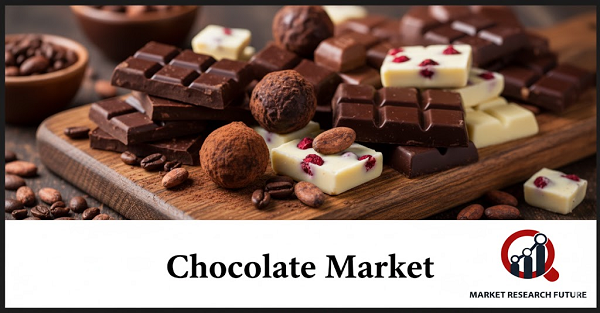
Chocolate Market Overview
The chocolate market was valued at USD 139.16 billion in 2024 and is projected to grow from USD 128.39 billion in 2025 to USD 232.88 billion by 2035, registering a CAGR of 4.94% during the forecast period.
The market’s growth is primarily attributed to the rising demand for premium and gourmet chocolates, along with the growing adoption of low-calorie and functional variants.
Increasing consumer preference for high-quality ingredients, unique flavors, and ethically sourced products is reshaping market dynamics, while health-conscious trends continue to influence purchasing behavior across regions.
Market Dynamics
The chocolate market is witnessing dynamic changes driven by evolving lifestyles and consumer preferences. The increasing popularity of dark chocolate, owing to its antioxidant properties and lower sugar content, has positioned it as a healthier alternative to traditional confectionery.
Meanwhile, the demand for ethically sourced and sustainable chocolates has surged as consumers prioritized transparency in supply chains. Manufacturers are investing heavily in sustainability programs to appeal to this growing demographic of socially conscious consumers.
Rising e-commerce adoption is another major growth driver. Online retail channels have expanded market access for both large and niche chocolate brands, creating opportunities for personalized and direct-to-consumer offerings.
Digital transformation has allowed brands to build stronger consumer engagement through customized packaging, limited editions, and subscription-based delivery models.
Market Segment Insights
By product type, the Chocolate Market comprises milk chocolate, dark chocolate, white chocolate, and ruby chocolate. Milk chocolate remained the largest segment, valued at USD 62 billion in 2024, with a projected increase to USD 90.5 billion by 2035. Its creamy taste and versatility continue to dominate the confectionery landscape.
Dark chocolate followed closely, growing from USD 38 billion in 2024 to USD 54.5 billion by 2035, supported by growing health awareness.
White chocolate, valued at USD 18 billion in 2024, is projected to reach USD 24 billion by 2035, while ruby chocolate, still relatively new, shows rapid growth potential, rising from USD 8.57 billion in 2024 to USD 13.56 billion by 2035.
In terms of distribution channels, supermarkets account for the majority of sales due to their extensive availability and wide product variety. Convenience stores maintain steady growth by targeting impulse buyers.
Online retail is expanding rapidly, offering global accessibility to artisanal and specialty chocolates. Specialty stores, though smaller in volume, cater to niche consumers focused on organic and premium chocolates.
By formulation, chocolate bars dominate global consumption, favored for their convenience and variety. Chips, beverages, and pouches also represent key growth areas, supported by rising demand for baking applications, indulgent drinks, and portable snack formats.
Among end-use segments, confectionery remains the largest consumer, followed by baking and snacking applications, reflecting the growing role of chocolate in both indulgent and functional food categories.
Regional Insights
Regionally, Europe held the largest share of the chocolate market, valued at USD 45.0 billion in 2024 and expected to reach USD 63 billion by 2035. The region’s deep-rooted chocolate culture, combined with demand for artisanal and sustainable offerings, supports consistent growth.
North America followed closely with a valuation of USD 30 billion in 2024, projected to grow to USD 42.56 billion by 2035, driven by innovations in premium and functional chocolates.
The Asia-Pacific region witnessed the fastest growth, expected to rise from USD 30 billion in 2024 to USD 51 billion by 2035. Increasing disposable income, exposure to global brands, and urbanization are key growth enablers in markets such as India, China, and Japan.
South America, particularly Brazil, showed steady growth from USD 15 billion to USD 20 billion during the same period, while the Middle East and Africa regions presented emerging opportunities despite current market limitations.
Competitive Landscape
The Chocolate Market is characterized by intense competition and continuous product innovation. Key companies include Ferrero International S.A., Mars Incorporated, Lindt & Sprüngli AG, The Hershey Company, Barry Callebaut AG, Cargill Incorporated, Patchi, Valrhona SAS, Confiserie Leonidas S.A., and Neuhaus.
Leading manufacturers are investing in sustainable sourcing programs, plant-based formulations, and digital marketing strategies to enhance customer engagement.
Recent industry developments highlight an emphasis on sustainability and innovation. In September 2023, Ferrero announced new commitments toward supply chain transparency.
Barry Callebaut partnered with Ghirardelli in July 2023 to strengthen their presence in the specialty chocolate market, while Nestlé expanded its plant-based portfolio with a dairy-free chocolate line in 2021. These initiatives underscore the market’s transformation toward ethical, premium, and health-oriented products.
Key Findings
- The global chocolate market is set to grow from USD 139.16 billion in 2024 to USD 232.88 billion by 2035, at a CAGR of 4.94%.
- Premium and artisanal chocolates are gaining strong momentum, particularly in Europe and North America.
- The Asia-Pacific region will witness the fastest expansion due to changing lifestyles and rising urban consumption.
- Sustainability and ethical sourcing are becoming major differentiators for global brands.
- E-commerce and direct-to-consumer sales channels are reshaping distribution dynamics.
- Dark and functional chocolates are leading product innovation trends, catering to health-conscious consumers.
Get More Information about this Report: Chocolate Market